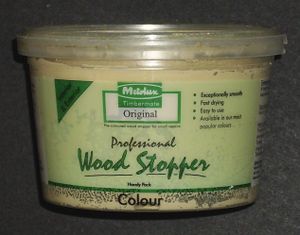Difference between revisions of "Filler"
| (One intermediate revision by the same user not shown) | |||
| Line 10: | Line 10: | ||
* Not waterproof | * Not waterproof | ||
* tough enough to put [[wallplug]]s into | * tough enough to put [[wallplug]]s into | ||
| + | * In very shallow dents it can fail to stick or fail to leave a decent surface | ||
==Decorators Caulk== | ==Decorators Caulk== | ||
| Line 37: | Line 38: | ||
[[Adhesive|Car body filler (polyester resin)]] is a tough durable quick setting filler used where good strength and prompt setting are necessary. | [[Adhesive|Car body filler (polyester resin)]] is a tough durable quick setting filler used where good strength and prompt setting are necessary. | ||
| + | |||
| + | Wood filler ends up showing up badly on woods that darken over time eg spruce, pine etc. | ||
==Car body filler== | ==Car body filler== | ||
Latest revision as of 15:51, 28 June 2017
This article is all about common fillers used for DIY applications.
Decorating filler
The classic example of this is "Polyfiller" a powdered plaster like filler that is mixed and applied. Sets to a hard long lasting finish that may be sanded to achieve a very smooth finish.
- Does not shrink much as it dries
- Sands well
- Takes paint and other finishes well
- Not flexible
- Not waterproof
- tough enough to put wallplugs into
- In very shallow dents it can fail to stick or fail to leave a decent surface
Decorators Caulk
A ready mixed acrylic water based filler that is ideal for filling difficult corners and cracks when decorating. Easy to work, and good for joints that may be subject to vibration and movement (e.g. along skirtings, door frames, into corners etc). Can be used to hide slight gaps between some sheets of wallpaper.
- Dries quickly and can be overpainted
- Can be removed with damp sponge while wet
- remains slight flexible to accommodate movement.
- Can't be sanded - must be tooled smooth when wet
- Shrinks a bit on curing, so not good for filling holes in walls.
Fine surface filler
- Good for shallow marks, dents etc
- Fine finish
- Shrinks
- Thus no use for bulk filling
Wood filler
Standard wood filler is an acrylic based mixture that's weaker than chipboard. If used in bulk the filler shrinks and cracks.
Linseed putty can be used as a harder tougher wood filler, but setting is extremely slow, and the filler must be undisturbed while it gradually sets.
Car body filler (polyester resin) is a tough durable quick setting filler used where good strength and prompt setting are necessary.
Wood filler ends up showing up badly on woods that darken over time eg spruce, pine etc.
Car body filler
Car body filler is a 2 pack polyester resin with many DIY uses.
- filling steel window frames
- filling wood frames where high strength & durability are needed
- moulding detail sanding blocks
- repair pipe damage
- tougher replacement for 'no more nails'
- repair screw holes in kitchen cabinets & flatpack furniture
- cast small appliance parts
- car body repair
- repair rust holes in appliances
- repair small bits of damage to concrete (mix with sand for this)
Lightweight Filler
A recent development in fillers is the introduction of 'lightweight fillers' sold under the brand names Red Devil ONETIME Filler, Everbuild One Strike, Wickes Fast Fill etc. They apparently contain lightweight polymer bubbles. These do not crack, shrink, or sag and require little or no sanding. They can be overpainted in 30 minutes or so.
Plaster
Plaster gets used as filler. Its very cheap but doesn't behave as well.
